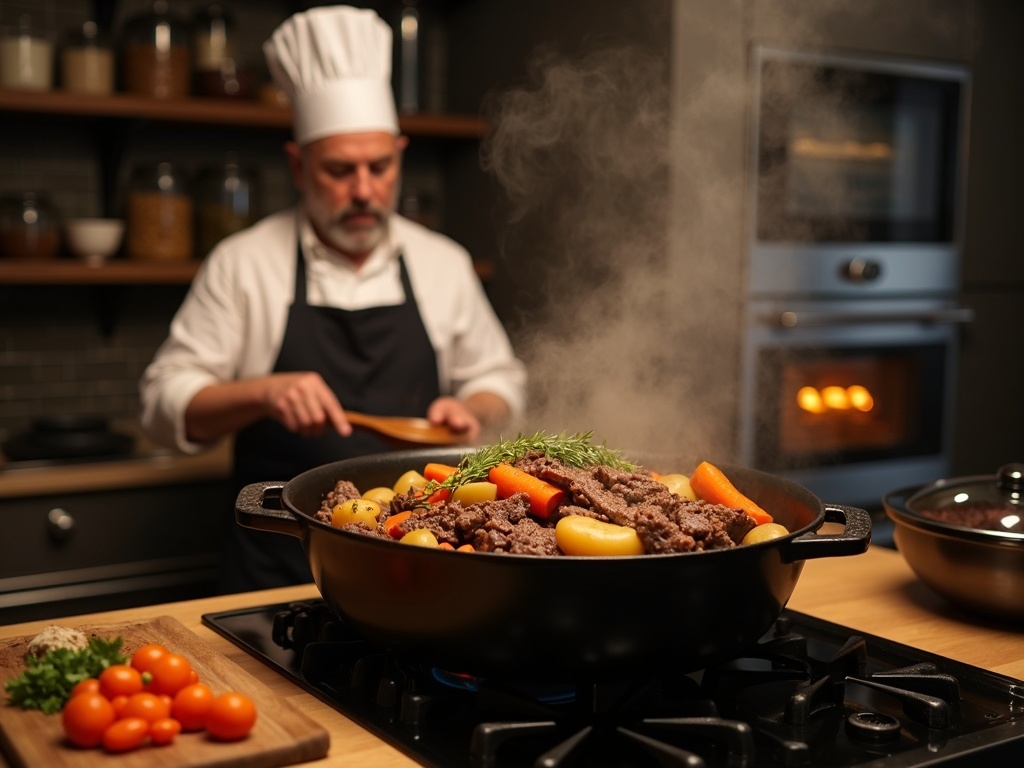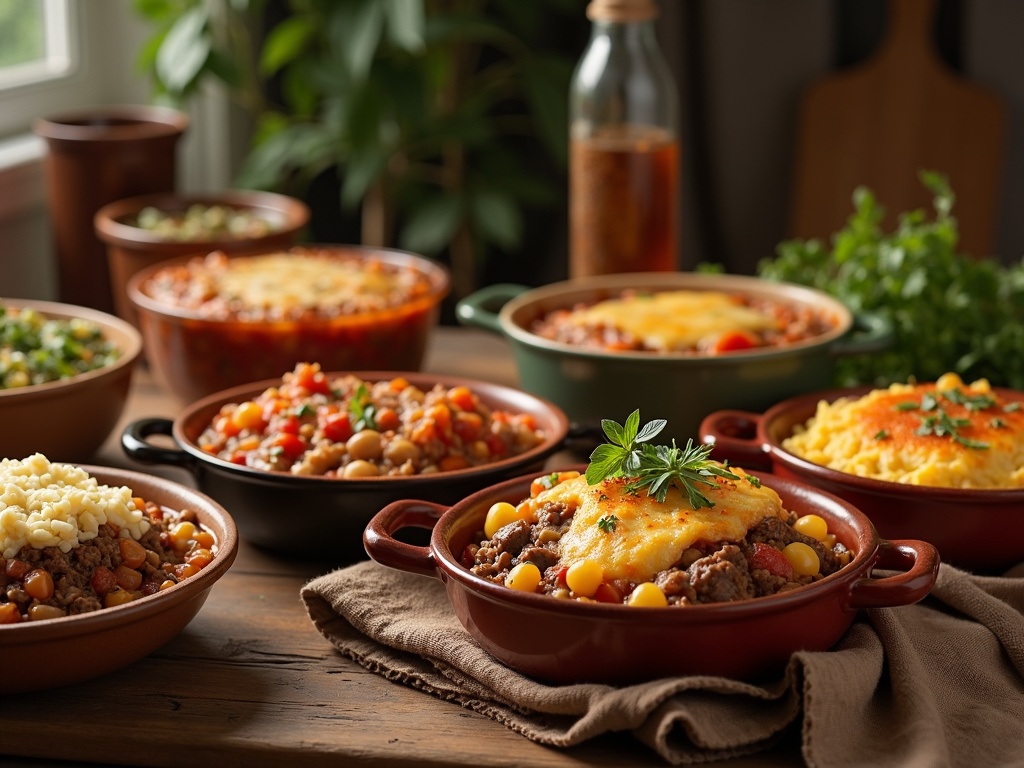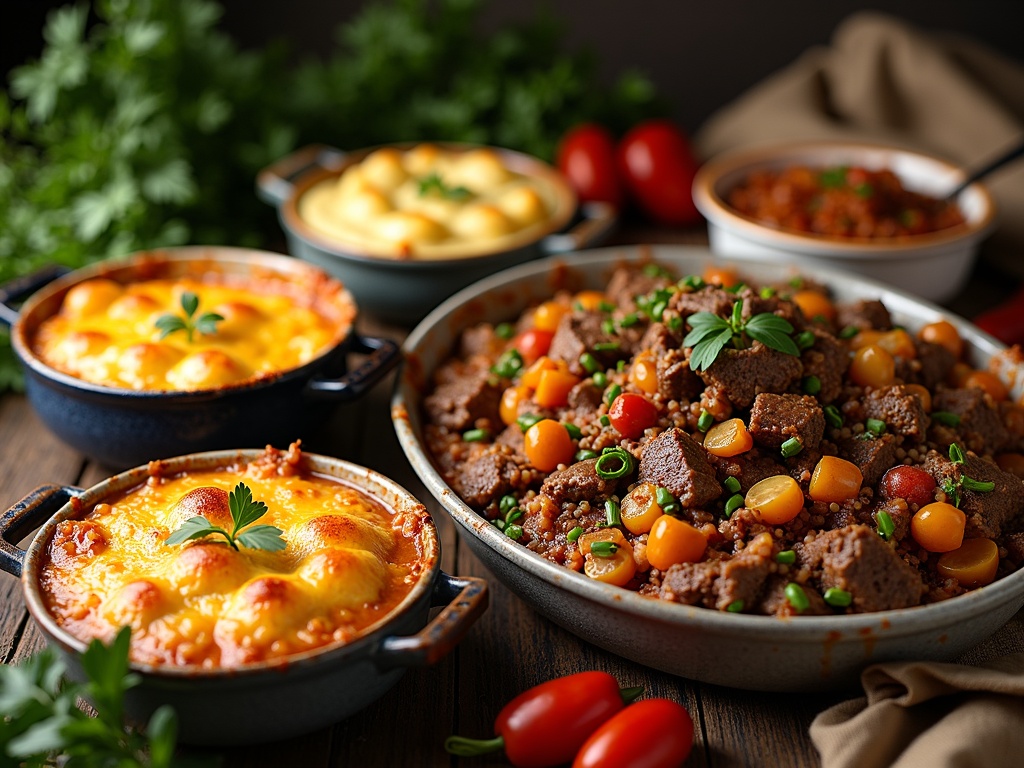Beef casserole has established itself as a versatile comfort food with remarkable staying power across diverse culinary traditions worldwide. With the global beef market valued at $320 billion in 2021 and growing steadily, this hearty dish continues to evolve through regional variations while maintaining its core appeal of tender meat, rich sauce, and satisfying depth.
Find In This Article
Key Takeaways
- Beef casserole offers exceptional adaptability, working well with premium cuts or economical mince beef while transforming even tougher cuts into fork-tender bites through slow cooking.
- The dish delivers significant nutritional benefits, providing complete protein alongside essential micronutrients like iron, vitamin B12, and zinc that are more bioavailable than in plant-based alternatives.
- A balanced beef casserole typically follows a 1:1:2 ratio of meat:vegetables:starch by volume, with lean ground beef (85/15) forming the protein foundation.
- Professional cooking techniques like proper browning, moisture control, and layering significantly enhance flavor development and texture.
- Regional variations showcase the dish’s global appeal, from British cottage pie and Hungarian goulash to Asian-inspired versions, each reflecting unique cultural influences and ingredients.
Why Beef Casserole Remains a Global Favorite
Beef casserole stands as one of the most enduring comfort foods across cultures, with good reason. The global beef market was valued at an impressive $320 billion in 2021, and it’s growing at a compound annual growth rate (CAGR) of 3.78% through 2030. These numbers reflect what many of us already know intuitively – beef dishes, particularly hearty casseroles, have a special place in kitchens worldwide.
Regional Variations That Capture Hearts
I’ve noticed how beef casseroles take on fascinating regional characteristics while maintaining their core appeal of tender meat, rich sauce, and satisfying depth. These variations showcase the versatility of this beloved dish:
- British-style cottage pie topped with mashed potatoes
- Hungarian goulash with its distinctive paprika-forward profile
- American midwest hotdish featuring mixed vegetables and creamy sauces
- Middle Eastern maqluba with aromatic spices and rice
- Japanese nikujaga combining beef with potatoes in a sweet-savory sauce
The statistics back up this popularity – approximately 50% of U.S. households regularly prepare some form of casserole, with beef variations consistently ranking among the favorites. This isn’t surprising given how easily a sausage casserole or beef-based one-pot meal fits into busy family schedules.
What makes beef casseroles particularly appealing is their adaptability. I can use anything from premium cuts to economical mince beef recipes depending on my budget. The slow-cooking process transforms even tougher cuts into fork-tender bites, making it both practical and delicious.
The secret to a great beef casserole often lies in the technique. Learning how to cook ground beef properly before adding it to your casserole can make all the difference. I always brown the meat first to develop those complex flavors that form the foundation of the dish.
For those looking to explore international flavors, trying a beef teriyaki inspired casserole can bring Japanese influence to this classic comfort food. The sweet and savory notes pair surprisingly well with the traditional casserole format.
The staying power of beef casserole comes from its perfect balance of nutrition, convenience, and flavor. It provides complete protein, can be prepared in advance, and typically improves in flavor over time – making it ideal for batch cooking and meal planning in today’s fast-paced world.
Essential Nutrients and Health Benefits
Beef casserole stands out as a nutritionally dense dish, offering a substantial amount of protein alongside vital micronutrients. A typical one-cup serving contains between 200-400 calories, making it a moderate calorie option that can fit into various dietary plans. The caloric content varies based on the specific ingredients used and cooking methods employed.
The star nutritional component of cottage pie and similar beef casseroles is undoubtedly the protein content. With approximately 25 grams of protein per 3-ounce beef serving, these dishes help support muscle maintenance, immune function, and overall cellular health. This protein amount represents roughly half of the daily recommended intake for the average adult.
Vitamin and Mineral Profile
Beef casseroles deliver an impressive array of essential micronutrients that are harder to obtain from plant sources alone:
- Iron: Contains approximately 2.7 mg of highly bioavailable heme iron per serving, which is more easily absorbed than plant-based iron sources
- Vitamin B12: Crucial for nerve function and red blood cell formation, and primarily found in animal products
- Vitamin B6: Supports brain development and function while helping the body convert food into energy
- Zinc: Enhances immune function and wound healing
- Selenium: Acts as an antioxidant protecting cells from damage
According to the American Heart Association, while beef provides these valuable nutrients, moderation remains key. They recommend limiting red meat consumption to 1-2 servings per week as part of a heart-healthy diet pattern.
When comparing beef casseroles to plant-based alternatives, I’ve found that while vegetarian options may provide fiber and different antioxidants, they typically require careful combination of multiple plant proteins to match beef’s complete amino acid profile. Ground beef recipes deliver nutrients in their most bioavailable forms, particularly B12 and iron.
For those concerned about fat content, leaner mince beef recipes can reduce saturated fat while maintaining nutritional benefits. Many casserole variations also incorporate vegetables, legumes, and whole grains, creating a balanced meal that provides carbohydrates, fiber, and additional vitamins alongside beef’s protein and mineral content.
By incorporating diverse beef preparations into your meal rotation alongside plenty of plant foods, you can enjoy the nutritional benefits of beef casseroles while maintaining dietary balance.
Master Recipe: Essential Ingredients and Proportions
Creating a delicious beef casserole starts with understanding the fundamental components that make this dish hearty and satisfying. Ground beef, which accounts for 55% of U.S. beef consumption, forms the protein backbone of most casserole recipes. I prefer using lean ground beef (85/15) for a good balance between flavor and health, but how to cook ground beef properly makes all the difference in the final dish’s taste.
Building Your Casserole Base
The traditional vegetable trio for beef casseroles includes carrots, onions, and garlic. These aromatics create a flavor foundation that complements the savory notes of beef. For a standard family-sized casserole (serving 4-6 people), I recommend:
- 1.5 pounds of ground beef
- 1 large onion, diced
- 2-3 carrots, sliced or diced
- 2-4 garlic cloves, minced
- 1 cup beef broth
- 2-3 tablespoons tomato paste for richness
The starchy component provides substance and helps absorb the delicious flavors. You can use 2 cups of pasta like penne or elbow macaroni in dishes similar to cottage pie recipes, or 1.5 pounds of diced potatoes for a heartier approach. Each creates a distinctly different casserole experience.
For those looking to mix things up, common variations include adding bell peppers, mushrooms, or peas. You might also experiment with different ground meats – try a 50/50 blend of beef and lamb for a richer flavor profile similar to traditional mince beef recipes.
Health-conscious cooks can make smart substitutions without sacrificing flavor. Consider swapping regular pasta for whole grain varieties, using cauliflower instead of potatoes, or incorporating more vegetables. Some sausage casserole techniques work well with beef too, especially when focusing on building layers of flavor through proper seasoning.
The secret to a perfect beef casserole lies in proper proportions. I maintain a ratio of 1:1:2 for meat:vegetables:starch by volume. This ensures a balanced dish where no single component overwhelms the others. For liquid components, add just enough to keep things moist during cooking – about 1-1.5 cups total for a standard casserole.
For an Asian-inspired twist, incorporate elements from beef teriyaki by adding soy sauce, ginger, and a touch of honey to your seasoning mix. This creates a fusion casserole that brings unexpected but welcome flavors to the table.
Professional Cooking Methods and Tips
Mastering the art of a perfect beef casserole requires understanding key cooking techniques that bring out rich flavors and tender textures. I’ve found that patience pays off when preparing this hearty dish, with most recipes requiring 1.5-2 hours of cooking time.
Slow Cooking Benefits and Temperature Guidelines
Slow cooking works wonders for tough cuts of beef. The extended cooking time breaks down connective tissues, transforming otherwise chewy meat into fork-tender bites. This method is ideal for budget-friendly cuts like chuck, brisket, or shin.
For oven baking:
- Set temperature at 325°F (165°C) for even cooking
- Cover tightly for the first hour to trap moisture
- Remove the lid for the final 30 minutes to develop a caramelized top
For stovetop cooking:
- Maintain a gentle simmer (small bubbles, not rolling boil)
- Keep temperature between 180-200°F (82-93°C)
- Stir occasionally to prevent sticking
When using a slow cooker, I’ve found the low setting (around 200°F) works best for 6-8 hours, while the high setting (around 300°F) reduces cooking time to 3-4 hours.
Essential Techniques for Perfect Results
Proper browning techniques make all the difference in a beef casserole. I always pat the meat dry with paper towels before browning—moisture is the enemy of a good sear. Working in small batches prevents overcrowding, which steams rather than browns the meat.
The way ingredients are layered significantly impacts the final dish. I use this optimal layering strategy:
- Start with a thin layer of sauce to prevent sticking
- Add browned meat next for maximum flavor development
- Layer root vegetables like carrots and potatoes, which need longer cooking
- Add quicker-cooking vegetables (mushrooms, peas) in the final 30 minutes
- Finish with fresh herbs just before serving
While traditional oven baking produces deeper flavors through caramelization, stovetop casseroles offer the advantage of easier monitoring and adjustment. I often combine methods—starting on the stovetop to brown meat and develop base flavors, then transferring to the oven to finish cooking.
For families looking for weeknight-friendly options, ground beef recipes can reduce cooking time to under an hour while still delivering satisfying results. For international variations, techniques from dishes like beef teriyaki can be incorporated to create fusion casseroles with unique flavor profiles.

Global Variations and Cultural Significance
Beef casserole dishes have gained incredible popularity across different cultures, each adding their unique twist to this hearty meal. I’ve discovered that while the basic concept remains similar—beef slow-cooked with vegetables and seasonings—the regional variations create distinctly different flavor profiles worth exploring.
International Beef Casserole Classics
American beef casserole typically features ground beef layered with vegetables and topped with cheese or biscuits for a comforting one-dish meal. It’s often made with condensed soups for creaminess and serves as a staple in family gatherings across the country.
The French have elevated beef casserole to an art form with Boeuf Bourguignon. This elegant dish simmers beef chunks slowly in red grape juice and beef stock with pearl onions, mushrooms, and bacon. Julia Child famously popularized this dish in America, showcasing how patience transforms tough cuts into tender, flavorful meat.
Hungarian goulash offers a different approach with its distinctive paprika-forward flavor profile. This hearty stew features beef cubes cooked with onions, paprika, and sometimes bell peppers until the meat becomes tender, creating a rich red sauce that’s often served with bread or pasta.
In Britain, cottage pie offers a comforting variation where minced beef is topped with mashed potatoes and baked until golden. This traditional dish has warmed British homes for generations, especially during cold winter months.
Regional Ingredients and Cultural Significance
The ingredients used in beef casseroles vary significantly by region:
- Mediterranean versions might include olives, tomatoes, and herbs like oregano and basil
- Asian-inspired dishes such as beef teriyaki casseroles incorporate soy sauce, ginger, and sesame
- Latin American variations often feature chilies, corn, and beans
- Middle Eastern versions might include aromatic spices like cinnamon, cardamom, and cumin
Beef casserole dishes carry deep cultural significance beyond their flavors. In many cultures, they represent community dining and family traditions. The casserole concept itself emerged from practical needs—using affordable cuts of meat and extending meals during lean times.
Learning how to cook ground beef properly forms the foundation for many of these global variations. The technique of browning the meat before slow-cooking helps develop those deep, complex flavors that make beef casseroles so satisfying across cultural boundaries.
These dishes often tell stories of cultural exchange and adaptation. The American casserole boom in the mid-20th century, for instance, reflected changing household dynamics and the rise of convenience foods, while traditional European versions showcase centuries-old cooking techniques passed through generations.

Sources:
Statista, Nutritional Composition of Ground Beef – USDA, Comprehensive Guide to Casseroles – Food Network, Top Casserole Recipes – Allrecipes

